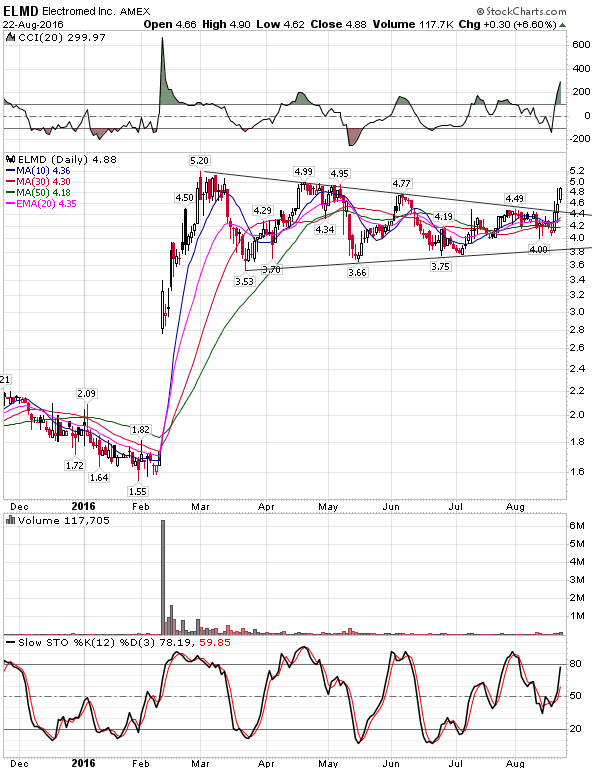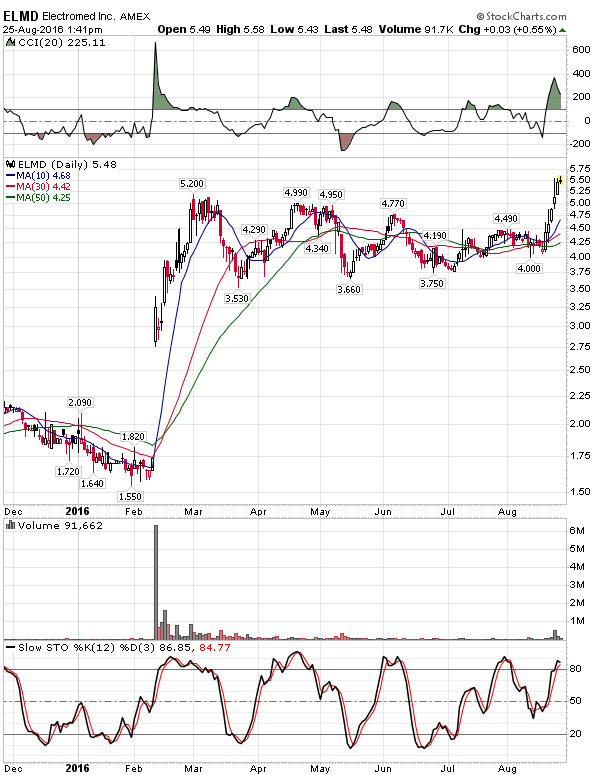Enormous Symmetrical Triangle Breakout – ELMD
Large Symmetrical Triangle Patterns
So what’s better than a very bullish chart pattern on a great stock? How about 2 bullish chart patterns!
Last year we released a video sharing with our audience how we found ANAC before it soared more than 120% within a couple months.
One of the keys to this trade was the multiple bullish chart patterns. A cup with handle pattern with another cup with handle on a shorter time-frame within the handle of the larger pattern.
Some traders and investors are looking primarily at daily charts covering the past few months to years. Some traders are focusing just on the past few weeks or few days.
So if you have bullish chart patterns on multiple time-frames, you have more traders and investors that may jump in to help to push the stock higher.
And sometimes you have more than 1 pattern on the same time-frame as well. A good example is ELMD which was a terrific trading triangle and was one of the two top trading setups this week in the Weeky Alert.
This is a great example of a large, bullish chart pattern that I mention in our newsletters but have not brought up on the blog or main site up until now. Its the symmetrical triangle pattern.
So lets take a look at it because its one of the most bullish continuation patterns.
 Swing Trading Setup – Symmetrical Triangle Pattern
Swing Trading Setup – Symmetrical Triangle Pattern
So lets define this pattern. A symmetrical triangle is when you have both lower highs and higher lows being made as time goes on. Over time, the highs get closer to the lows until the price has to break out in either direction.
To be a valid pattern, you need at least 2 lower highs and 2 higher lows. The highs and lows need to about line up in a straight line connecting them.
Now what happens is that short sellers short near the highs as the price starts to turn and then often put a stop just above the prior high and above the top trendline. Those trading to the long side buy the stock and then often put a stop beneath the prior low and bottom trendline.
So this adds buying pressure if the price breaks out of the top of the pattern and adds sellers if the price breaks below the lows of the pattern.
In both cases, notice the direction of a trend is not confirmed by taking out the prior high or by taking out a prior low as the symmetrical triangle develops. Taking out the prior low would confirm a trend change to the downside. Taking out the prior high would confirm the trend change to the upside.
This is a continuation pattern meaning the price tends to break out in the same direction it was heading before the pattern started.
The one we found this week was a very large pattern on a small cap stock with strong growth in sales and earnings with a reasonable valuation. A stock that has also beaten estimates 3 of the past 4 quarters with steady future estimates. We prefer rising estimates but the fact that they beat 3 of the past 4 quarters is a good sign.
We only feature strong growth stocks and/or stocks beating estimates with rising future expectations. This gives us an edge over pure technical strategies.
Symmetrical Triangle Entries/Exits
The entry point is a close above the upper trend line if you are playing a long trade. And below the lower trend line if you are shorting or buying put options. Again, you want to play a breakout in the same direction of the trade.
Now this stock happened to gap higher after we featured it and reached our target sell price for about a 10% profit within 15 minutes earlier this week.
 Swing Trading – Made 10% profit Target in less than 15 mins.
Swing Trading – Made 10% profit Target in less than 15 mins.
When a trade like this gets off to a such a good start we often keep a portion of our shares until the next uptrend is broken or another bearish technical event. It could make a much larger move since its only trading for about 20 times earnings with good growth and about 15 times next years expected earnings which they tend to beat.
At this point the risk/reward ratio does not justify entering a new trade. However, those subscribed to our newsletter can just let a portion of your profits ride while stopping the remaining shares at your entry point.
You see symmetrical triangle patterns not only when swing trading on daily charts but also when day trading. And they are often successful on stocks in strong trends that day in the morning before 11am and sometimes later when the market and stock are moving strongly that day.
Get Ideal Trading Setups with Rapidly Improving Fundamentals Poised to Move This Week






